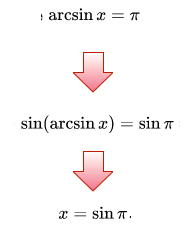Can We Trust Her?

Michaelle asked the classroom to solve for . After some minutes, she wrote the equation on the blackboard. She solved it as follows:
"Due to the fact that the arcsine of is defined as the inverse sine function of , we can write . We have that , so the unique solution to this equation is ."
Is this reasoning correct?
This section requires Javascript.
You are seeing this because something didn't load right. We suggest you, (a) try
refreshing the page, (b) enabling javascript if it is disabled on your browser and,
finally, (c)
loading the
non-javascript version of this page
. We're sorry about the hassle.
The definition of arcsin x (for real x ) is the value y in the interval [ − 2 π , 2 π ] such that sin y = x . Since π is outside that interval, by definition there is no x that will give arcsin x = π . The reason that the extraneous solution x = 0 is obtained is because sin π = 0 ; however, we also have sin 0 = 0 , so arcsin 0 = 0 instead of arcsin 0 = π .